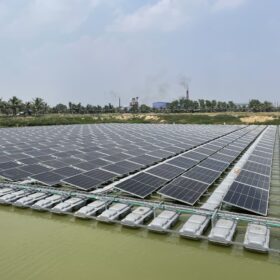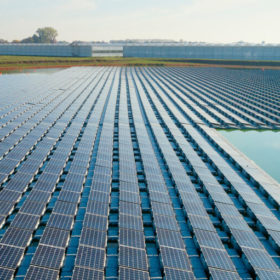Comprehensive review of all water-related PV technologies stresses need for careful planning
A new study of existing research on water-based PV (WPV) technologies points to gaps in published reports on the technologies, particularly regarding environmental impacts, in general, and cost analyses for canal top solar, specifically.
Impact of floating photovoltaics on thermal characteristics of lakes
A new study details how floating photovoltaics impact wind flow and irradiance on lakes, with the effect of influencing water temperature at different depths. However, the report’s authors say more research is needed on how to design systems for maximum benefit to the water bodies themselves.
EDF commissions utility-scale floating solar plant in France
EDF’s new 20 MW floating solar project is built close to an EDF hydropower dam near Lazer, in southern France.
Floating solar tech for harsh offshore conditions
An international research team has designed a floating PV system that can reportedly withstand wave heights above 10 meters. The system uses splitters to link one mooring tether to multiple floating modules. This reportedly ensures sufficient structural capacity, while avoiding the need for too many mooring lines.
Ciel & Terre hits 1.5 GW floating PV pipeline
French floating PV specialist Ciel & Terre says it now has more than 1.5 GW of floating PV projects in the design phase or under construction. It has already completed 280 floating solar projects in more than 30 countries, totaling 820 MW.
Floating solar may reach LCOE of $0.0341/kWh in Bangladesh
New research shows that floating PV plants may have superior generating capabilities compared with ground-mounted PV plants in several areas of Bangladesh. Furthermore, the study indicates that floating arrays in the country may reach a levelized cost of energy ranging from $0.0341/kWh to $0.0486/kWh depending on the location.
Akuo finalizes floating solar project in France
Akuo, a French independent power producer, has secured a 20-year power purchase agreement for a 8.7 MW floating PV array in southern France.
Bangladesh switches on nation’s largest floating PV plant
Joules Power has switched on Bangladesh’s largest floating PV plant, with an installed capacity of 3.2 MW. The facility, which is situated on a fish pond, will supply electricity to a nearby rice mill.
Portugal launches floating solar tender
Portugal will auction off five projects with a combined capacity of 4.5 MW. They require a total investment of around €4.3 million ($4.6 million).
Annual floating solar additions to top 6 GW by 2031, says WoodMac
The global floating solar (FPV) market is expected to keep up its steady growth, as the Asia-Pacific region continues to lead demand.










